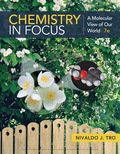
Interpretation:
The contaminants that pose immediate health risks and the contaminants that can be eliminated by boiling are to be stated.
Concept Introduction:
Water is a common liquid that is present on the Earth.
It is also known as universal solvent. It can dissolve a wide range of organic and inorganic solutes.
Water is vital for the existence of all living animals. Without water, no life form can exist, it constitutes an important part of rivers, lakes, streams, clouds, snow and ice.
Water is truly an unusual molecule such that being a low molar mass compound, it exists as a liquid at room temperature and has an anonymously high boiling point.
Ice floats on water because it has a lower density than water.
Water contains some unwanted particles which can lead to diseases and other hostile effects on human health.
Numerous types of micro-organisms such as bacteria are present in water, which contaminate the water.
Biological contaminants: Some microbes can live in water and can cause various diseases like cholera, dysentery, and so on. Two examples of such microbes are Giardia and Legionella.
Inorganic contaminants: Some inorganic molecules can dissolve in water and make it impotable (not suited for drinking). Two examples of such molecules are Nitrates and Asbestos.
Organic contaminants: Some organic molecules can dissolve in water and makes it impotable (not suited for drinking). Two examples of such molecules are chlorohydrocarbons (volatile) and ethylbenzene (non-volatile).
Radioactive contaminants: Some radioactive elements can dissolve in water and make it impotable (not suited for drinking). Two examples of such elements are Uranium and Radium.
Contaminants that pose immediate health risks are the biological contaminants and inorganic contaminants because they get immediately dissolved in blood and starts reacting with it.
Contaminants that can be eliminated by boiling are the biological contaminants because the microbes can be killed by increasing the temperature.
Want to see the full answer?
Check out a sample textbook solution
Chapter 12 Solutions
Chemistry In Focus
- A mixture of C7H12O2, C9H9OCl, biphenyl and acetone was put together in a gas chromatography tube. Please decide from the GC resutls which correspond to the peak for C7,C9 and biphenyl and explain the reasoning based on GC results. Eliminate unnecessary peaks from Gas Chromatography results.arrow_forwardIs the molecule chiral, meso, or achiral? CI .CH3 H₂C CIarrow_forwardPLEASE HELP ! URGENT!arrow_forward
- Identify priority of the substituents: CH3arrow_forwardHow many chiral carbons are in the molecule? OH F CI Brarrow_forwardA mixture of three compounds Phen-A, Acet-B and Rin-C was analyzed using TLC with 1:9 ethanol: hexane as the mobile phase. The TLC plate showed three spots of R, 0.1 and 0.2 and 0.3. Which of the three compounds (Phen-A; Acet-B or Rin-C) would have the highest (Blank 1), middle (Blank 2) and lowest (Blank 3) spot respectively? 0 CH: 0 CH, 0 H.C OH H.CN OH Acet-B Rin-C phen-A A A <arrow_forward

 World of Chemistry, 3rd editionChemistryISBN:9781133109655Author:Steven S. Zumdahl, Susan L. Zumdahl, Donald J. DeCostePublisher:Brooks / Cole / Cengage Learning
World of Chemistry, 3rd editionChemistryISBN:9781133109655Author:Steven S. Zumdahl, Susan L. Zumdahl, Donald J. DeCostePublisher:Brooks / Cole / Cengage Learning Introductory Chemistry: A FoundationChemistryISBN:9781337399425Author:Steven S. Zumdahl, Donald J. DeCostePublisher:Cengage Learning
Introductory Chemistry: A FoundationChemistryISBN:9781337399425Author:Steven S. Zumdahl, Donald J. DeCostePublisher:Cengage Learning Chemistry for Today: General, Organic, and Bioche...ChemistryISBN:9781305960060Author:Spencer L. Seager, Michael R. Slabaugh, Maren S. HansenPublisher:Cengage LearningChemistry: Matter and ChangeChemistryISBN:9780078746376Author:Dinah Zike, Laurel Dingrando, Nicholas Hainen, Cheryl WistromPublisher:Glencoe/McGraw-Hill School Pub Co
Chemistry for Today: General, Organic, and Bioche...ChemistryISBN:9781305960060Author:Spencer L. Seager, Michael R. Slabaugh, Maren S. HansenPublisher:Cengage LearningChemistry: Matter and ChangeChemistryISBN:9780078746376Author:Dinah Zike, Laurel Dingrando, Nicholas Hainen, Cheryl WistromPublisher:Glencoe/McGraw-Hill School Pub Co Chemistry: The Molecular ScienceChemistryISBN:9781285199047Author:John W. Moore, Conrad L. StanitskiPublisher:Cengage Learning
Chemistry: The Molecular ScienceChemistryISBN:9781285199047Author:John W. Moore, Conrad L. StanitskiPublisher:Cengage Learning





